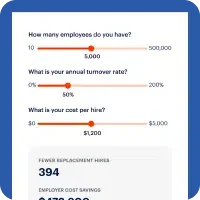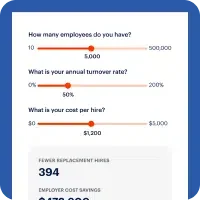Employee turnover negatively impacts your organization through high costs and lower productivity.1
Monitoring and calculating the true costs of employee turnover is an important mission for any business.
However, fully understanding turnover costs can be difficult, since many qualitative and quantitative factors determine the cost of turnover for a business. On top of these direct impacts on your business such as the costs of employee turnover, your employees will also feel the repercussions of high employee turnover.
Let’s look at a few more negative effects of employee turnover on your business and employees.
Negative Impacts on Employee Engagement
Actively disengaged employees can be toxic to your work environment in the months and weeks leading up to their departure.2
Not only are they dissatisfied at work, but they may be vocal about their dissatisfaction with other employees. This negativity can impact workplace morale. Otherwise-engaged employees may start to lose their faith in and loyalty to your organization.
According to Gallup, there are two types of employees to which you should pay attention.3
Engaged Employees:4
- According to research from Gallup, 36% of U.S. employees are engaged at work.
- Elements of engagement include clarity of job expectations, growth opportunities and opinions counting at work.
- Engaged employees are involved in and enthusiastic about their work and workplace.
Disengaged Employees:5
- According to research from Gallup, the percentage of actively disengaged employees is up slightly in the U.S., from 14% in 2020 to 15% through June 2021.
- Actively disengaged employees report miserable work experiences and are generally poorly managed.
- Among actively disengaged workers in 2021, 74% are actively looking for a new job or watching for an opening.
Decreased Productivity and Output
This is a multi-pronged issue. First, it’s jarring to your productivity and efficiency when valuable employees leave.
When one person on the team leaves, it takes time for people to learn how to work together, communicate product changes or improvements and get back into a productive workflow. Each time there is a significant change to personnel, this may diminish the quality of your productivity and an end goal — whether this is product quality or customer service.
Additionally, training new hires is only a fraction of the education. Long-time employees have a deep history with your company, filled with important information that helps them do their jobs more effectively.
Years of “on-the-job training” allow employees to solve complex problems when they arise independently. When turnover happens, you’re not just losing an employee, you’re losing the years of experience that person had. These knowledge gaps can be hard to fill, and your product can take a hit as a result.
When a product’s value decreases, customers notice. Organizations with high turnover tend to have lower-than-average customer satisfaction and loyalty. This negativity from customers is often handled by your employees, which can put stress and frustration into your workspace.
Revenue Declines Affect Employee Treatment
If your turnover is high, the money to fund attrition must come from somewhere.
Without properly budgeting for turnover, it can decrease the ability to treat your employees to culture-focused perks or rewards. A decreased “fun budget” can start to lower morale at your company.
Improve Employee Retention With Earned Wage Access
Above all, it’s important for you to identify the problems and rectify turnover if it’s a problem at your organization.
To ensure your work environment stays happy and productive, further your understanding of what causes employee turnover.
1 https://www.randstadusa.com/business/business-insights/employee-retention/focusing-high-cost-employee-turnover/ :DailyPay, 2020
2 https://www.gallup.com/workplace/352949/employee-engagement-holds-steady-first-half-2021.aspx :DailyPay, 2020
3 https://www.gallup.com/workplace/352949/employee-engagement-holds-steady-first-half-2021.aspx :DailyPay, 2020
4 https://www.gallup.com/workplace/352949/employee-engagement-holds-steady-first-half-2021.aspx :DailyPay, 2020
5 https://www.gallup.com/workplace/352949/employee-engagement-holds-steady-first-half-2021.aspx :DailyPay, 2020













